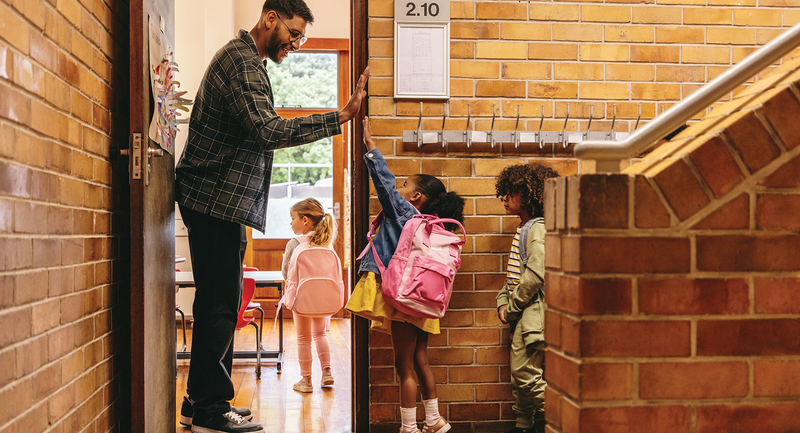Lots of school districts have mission statements, but Superintendent Susan Enfield offers students and parents something else—a promise. "Our promise is to know every student by name, strength, and need and to have them graduate prepared for college, career, and citizenship."
Enfield leads Highline Public Schools just south of Seattle. Since she arrived four years ago, the district has implemented new discipline rules, paid careful attention to biases that can deter some students from reaching their potential, and pushed to include more minorities in upper-level classes.
She's one of a wave of school leaders who are trying new methods to tackle an age-old problem—the achievement gap between minority and white students. These leaders don't eschew established educational practices, but they know that there's more to supporting success than curricula and test scores.
At nearby Mirror Lake Elementary School in Federal Way, a new social-emotional learning program cut office referrals by 30 percent, in large part by teaching students how to handle their emotions. Principal Jollene Vining says, "This change was just as important as our curriculum." Vining's school sits in the heart of Federal Way Public Schools, the most diverse district in the state of Washington.
For decades, inequalities faced by students of color have played out on standardized test results, high school and college graduation rates, and other academic measures. The modern-day concern over these gaps was crystallized by No Child Left Behind. The 2001 law forced school districts to disaggregate data results by various groups, thrusting the severity of the problem into the spotlight, grade by grade, subgroup by subgroup.
Although schools have made some progress in the past 16 years, the gap remains seemingly immune to elimination, perhaps because there is no one answer to solving this intractable problem. Systemic inequalities—like poverty, racism, school funding imbalances, and assignment of the most inexperienced teachers to the poorest schools—are just some of the reasons why minorities lag behind their white peers.
Tackling Teacher Bias
"I've always contended that we know what to do to close the achievement gap; it's just very difficult," says Karen Beerer, a former Pennsylvania superintendent who now works for Discovery Education. School districts, she explains, need an aligned curriculum, engaging and culturally relevant resources, and a way to assess students and intervene when their results don't meet expectations.
Kati Haycock, founder and former CEO of the Education Trust, agrees with Beerer's analysis. Before NCLB was passed, she wrote in Educational Leadership that research showed four main areas schools should concentrate on: establishing standards, creating a challenging curriculum, providing students with extra help when needed, and hiring high-quality teachers. When she testified in front of the U.S. Senate in 2016, she pointed out that National Assessment of Educational Progress (NAEP) test results for black and Latino students improved faster under NCLB than at any other time since the 1980s. Graduation rates for both groups also rose at least 10 points from 2003 to 2014.
Now, in addition to the academic measures highlighted by Haycock, leaders are looking to other areas, such as inequities in suspension rates and the role teacher bias may play in keeping students of color from taking the highest-level classes.
In the last several years, numerous studies have found that minorities, specifically black students, are suspended at rates much higher than white students. In 2014, the U.S. Commission on Civil Rights reported that 43 percent of students who received multiple out-of-school suspensions were black, although these students made up only 16 percent of the general student population. This pattern emerges as early as preschool. A 2016 Civil Rights Data Collection by the U.S. Department of Education showed that black preschool children are 3.6 times more likely than white children to receive one or more out-of-school suspensions.
One of Enfield's first moves in Highline was to address this disparity by eliminating out-of-school suspensions, except in cases where it is absolutely "critical for staff and student safety." It wasn't just the time out of school that pushed students further behind academically and led to lower graduation rates, the superintendent says. The mindset that these students needed to be punished more than their peers led to significantly lower rates of minorities taking advanced placement (AP) or International Baccalaureate (IB) courses. "People believe what they want to believe," Enfield says of teachers. "We set a standard and expectation. We change people's beliefs by giving them a different experience."
Since the district has reduced out-of-school suspensions from 2,200 in the 2011–12 school year to 450 this past year, other changes have followed. From 2013 to 2016, enrollment of black and Latino students in AP and IB classes increased by more than 20 percent. With regard to what Enfield calls the "ultimate marker"—graduation rates—these students experienced a dramatic rise in just three years. The rate of black students graduating jumped from 55 percent to 73 percent, and the rate of Latino students went from 50 percent to 71 percent.
Enfield credits the changes to the renewed efforts by staff to build better relationships with students. Instead of reflexively suspending students, she created a system in which students can get counseling and meet with specialists who are trained to address their behavioral challenges while keeping them current on their school work. In the absence of strong relationships with adults in their schools, students will act out, she says. "We're the grownups—we're responsible for turning their tough moments into teachable moments." In turn, connecting with students and encouraging them to take more challenging classes has led to improved student performance, she adds.
The superintendent admits that the suspension policy change, along with greater demands for all teachers, has led, in part, to double-digit teacher exit rates from Highline.
"It's not for the timid," she says of her plan. "We've taken a lot of heat for it." Still, she remains undeterred. "It's the right work. It's the work we have to do."
Removing Metal Detectors and Stigmas in Kansas City
Nearly 2,000 miles away in Kansas City, Missouri, some of the same work has been taking place in Hickman Mills School District. Superintendent Dennis Carpenter has cut out-of-school suspensions in half in his four years. He's not shy about stating the reason for the turnaround: getting staff members to recognize their implicit racial biases.
Although the student population is 90 percent minority, the teaching staff is about 75 percent white, with the vast majority of teachers living outside the district's borders.
"We have processes in place to have courageous conversations," Carpenter says. School equity teams have worked with teachers, administrators, and even board members to understand how people talk to one another and how those conversations can carry racial overtones. "We developed common language so we could interrupt some of those systemic practices that we know would lead to lower performance for our children of color." Teachers learn how to apply restorative practices and help students improve their decision making, he adds.
In addition to changing minds, he also changed hardware. When he arrived, all middle and high school students had to pass through metal detectors and undergo bag searches to enter the school building. He eliminated both of those practices, admitting that the change was a difficult one for the community to accept. The result, however? Schools are just as safe and attendance has increased by nearly 4 percent.
The focus on equity has led to other results as well: the district's graduation rate is up 10 percent, more students are taking AP classes, and test scores in most subjects have risen. Carpenter, who left Hickman Mills this summer to serve as superintendent of nearby Lee's Summit School District, hopes the trajectory will continue in his absence.
"A Promising Work in Progress"
The comprehensive strategic plan that Carpenter developed may help sustain some of those initiatives. Although setting up and following a strategic plan might sound like common sense, that doesn't undercut its importance, adds Vining. Making priorities clear to staff, the community, and students is a big part of getting everyone to pull together.
When Federal Way released its first strategic plan in 20 years, Vining says the stated goal of reducing the achievement gap led to better data collection, tightening the inquiry cycle (reducing the time between collecting and analyzing data), and more effectively using data to target personalized instruction.
Mirror Lake, the district's oldest school, has about 430 students. Nearly 90 percent of them are eligible for free and reduced-price lunch and 45 percent are English language learners. Despite these challenges, the school was able to show tremendous progress in just one year. Black and Latino students experienced significant gains in 3rd grade English language arts achievement.
"We're not surprised at our growth, but we are excited," Vining says.
Carpenter agrees about the importance of creating a strategic plan; in fact, he developed two when he took over as superintendent of Hickman Mills. The first plan, a one-year blueprint to give his district initial direction, bought time to create a more robust five-year strategic plan that carried the input of the staff and community. The second plan set the wheels in motion for a restorative justice program and the addition of full-day preK for all students. "The sooner we can get students acclimated to a school environment, the higher they can achieve. Kindergartners were showing up more [prepared] for school" this year, he says.
None of these districts claim to have "won" the battle against the achievement gap, but all take pride in their progress. Enfield sums up the sentiment when she says, "We are far from a success story. We are a promising work in progress."
"We'll never be able to make this easy," she adds. "Even on our best days, with everything in place, it's hard work. On the hard days, it's soul crushing. On good days, it will lift you up."








